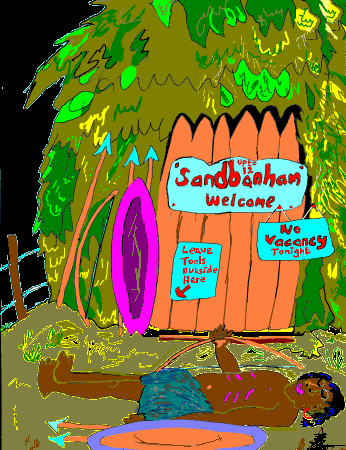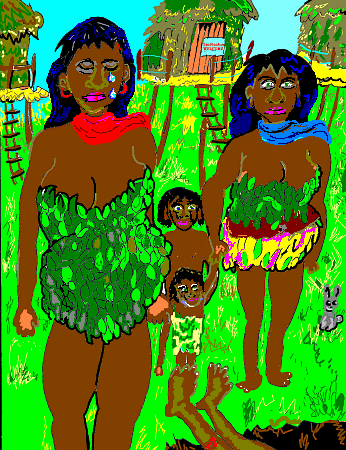|
Note: this is a basic overview of issues tackled in more depth in specialisation of families including a more thorough view of the Nayar. The images below are humorous and imaginary; in fact Nayar women lived in common dwellings where they had their own rooms.
|
Family: Universal Building Block?
We often hear it said that the family is the building block of society. Is it universal however, the basic unit of human organisation everywhere for child rearing economic security?
|
George Peter Murdock (1949) wanted to know if the family was not just cultural but universal. He claimed that it was universal.
|
- Common residence
- Economic co-operation
- Adults including both sexes
- At least two have socially approved sex
- One or more children
|
|
This he thought was the universal minimum. Which adults had sexual relations depended on the culture. He believed the nuclear family was the universal core of the world's large variety of kinship systems. From this a family could be extended vertically (with upper generations) or horizontally (with brothers and sisters of those with offspring).
|
A criticism of Murdock was that he was a desk social anthropologist regarding others' family studies, which he studied second hand.
To claim something is universal only needs one exception to falsify it. Is this what Kathleen Gough showed with the central tribes of common Nayar of Kerala, southern India. Family extends from marriage; her argument was about marriage. How did she define marriage?
|
Before reaching puberty Nayar women in India were married to a man according to the Talikettukalydnam rite. This three days of actual or mock defloration might be their last living contact.
|
|
From then on, as "mother", each woman would take up to twelve sandbanham husbands, who visited her one at a time at night. A man could have an unlimited number of wives. The woman kept her room in the house, and it was first come first served to supper and bed, so a man too late would sleep on the verandah of the house.
|
|
Clearly women getting pregnant could have any one of up to 12 as the father. So one of them of equal sub-caste declared as the father (whether he was or not) and gave a present of cloth and/ or vegetables to the attending midwife. A frequent visitor might send luxuries at festivals. That was it. The men were mercenary warriors and gave no attention to raising children or staying with the woman.
|
|
Support for the women instead came from brothers, sisters, and children of the sisters and daughters. The matrilineal family provided all her essentials. The eldest male was leader of each kin group. So the women lived not in families, but in kinship groups (mothers, sisters and brothers), and she had her place for sexual activity with the men over which she had considerable personal cotrol. Descent was down the stable female line in terms of charting the source of children, given that any man could be the father.
|
|
The important point here is that:
|
- There was no economic unit regarding husbands and wives.
- There was no sharing of the residence between husbands and wives.
- Only the women within their supporting kinship groups lived with children.
- Any relationship affection from the man was taboo and resisted by the kinship group.
|
There are two possibilities here, then, regarding Murdock and his definition of the family.
- It is too narrow, or
- It is not universal.
|
For Gough (1959) marriage was where a woman had a relationship with one or more men that led to her child having full birth status rights. So in essence Gough changes Murdock so that the family becomes universal because its rituals give social approval to offspring. Yet there does not seem to be much of a family. The sexual, economic and upringing functions are separated out, so to allow men to earn an income fighting. Only when the Talikettukalydnam rite married man dies does the woman display any obligation to him, by attending his funeral and mourning him, and thus men when dead can be mourned. This is part of their understanding of Hindu cleansing (pollution to purity pole, where Hinduism is crucial), as indeed was the separation after the original marriage.
|
So to go back in time...
|
The Nayar tribes in southern India does a lot of fighting for income, and develops a way of marriages to organise child-rearing given the amount of fighting done with men coming back when they can.
|
|
First of all they have the tali rite of pre-pubescent marrige. This means if a man dies someone special will mourn him but he has no further responsibilities towards her.
|

|
|
Once she grows up the once married young woman can start taking visiting husbands. When the male fighters come back they spread out to the various women. The woman will take up to twelve husbands, serving one at a time, but the man can take as many wives as he likes, only limited by the women's lists.
|

|
|
A warrior whose women are occupied that night will sleep outdoors. He knows that she has one of her husbands with her because his fighting tools are outside the door.
|

|
|
When her tali married man dies (she may never have slept with him) she mourns him, here whilst carrying the child of one of the twelve she sees.
|

|
West Africa
|
West Africa has its own tradition of arguably non-Murdock family, which is matriarchal, and this influenced the West Indies. In West Africa polygamy was (and is) common, in that one man has many wives, and the women retain much economic independence and run their own lives bringing up children.
|
|
An effect in the West Indies is that families are often matrifocal, where men can play no role in upbinging, and only women do, including maybe the mother of the mother.
|
|
Slavery was also an influence because the women with children were economic units on the plantation, whilst the slave owners and white employees had sex with these women and the black male was sidelined under the thumb of the slave owner.
|
|
The West Indian man today earns too little to maintain a family, and so deserts it leaving the structure matrifocal. Indeed, widespread poverty leads to matriarchal control.
|
|
Nevertheless these matriarchal families in the West Indies are the minority.
|
It is the single parent family, especially female-headed, that is the most direct criticism of Murdock. Yet this is a minority, and the family may at least have begun as a two sex nuclear family and, furthermore, the nuclear family is preferred by him. The nuclear family may simply function better as a family - but this is unproven. Nevertheless there are varieties of arrangements for raising children that stretch Murdock's definition to breaking point.
Matrifocal families are economic necessities due to poverty; matriarchal families are cultural outcomes of poverty and even choices. By not having just one husband, a woman may be able to make arrangements with several men and benefit economically from them for herself and in raising children.
Other contemporary criticisms is that Murdock did not consider gay and lesbian families. He wrote in 1949 and may well have been blind to homosexual men being in families (of course the relationships were known about, but subject to jokes and common ridicule and not considered to be part of families) and to lesbian families (these relationships were not even legislated against, and suffered from invisibility).
Social approval for relationships is necessary: all societies have values and norms in the arrangements for the crucial function of raising children, when they are in a family. But these values and norms are widely variable throughout the world.
Imagine...
What relationship and child upbringing structural arrangements might be devised for say the social economy of:
- Lorry drivers
- Armed forces
- Mountaineers
- An idealistic commune
- A cult with strong admired leadership
|
The Functions of the Family
|
Murdock had something to say about these too, which are to be distinguished from the structure of the family. He derived four functions.
|
|
Sexual : which he regarded as necessary for the family's parents to continue to bond together. There is an exchange theory here of giving to a relationship that brings more from it - the bonding together.
|

|
|
Reproductive : without which there would be no next generation.
|

|
|
Economic : by which parents could specialise their co-operation (e.g. earning money, housework or generally support one another and the family) without which the family could not sustain itself. Economic includes needs such as shelter and food, because these need resourcing.
|

|
|
Educational : by which parents pass on the norms and values of the society and act as agents of primary socialisation. They continue to be conservative in a sociological sense (functionalism is always about how things continue) and politically.
|

|
|
These definitions are not exclusive to the family, and the family performs many more functions (for example, leisure with entertainment functions). Although Murdock's study includes families that are not nuclear, he has a preference for the nuclear family in its efficiency of functionalism both towards the individuals in it and society at large.
|
|
As ever Murdock presents an optimistic picture of family life, without alternatives and without examining the lack of exclusivity of any of these functions and what this implies for the family being an efficient centre-piece of society.
|
Talcott Parsons has his basic and irreducible functions of the family too, for which he has two. The economic has been lost to other agencies in Western society and he does not include reproduction in the basic biological sense. These are:
- Primary socialisation
- Early years internalisation of culture pasing on norms and values
- Structuring of the personality in the early years
- Stabilisation of adult personality
- Marriage
- Emotional security
- The nuclear family relies on the married couple due to lack of kinship support
|
|
Parsons has idealised the family. It is Western, even American. It is middle class (does not consider working class culture and other subcultures where the family may be different). There are functional alternatives. Children interact with parents, so they influence the parents too.
|
Murdock, G. P. (1949), Social Structure, New York: MacMillan.
Gough, E. (1959), 'Is the Family Universal? The Nayar Case' in Bell, N. W., Vogel, E. F. (eds.), A Modern Introduction to the Family, London: Collier-MacMillan.
Adrian Worsfold
Pluralist - Liberal and Thoughtful







